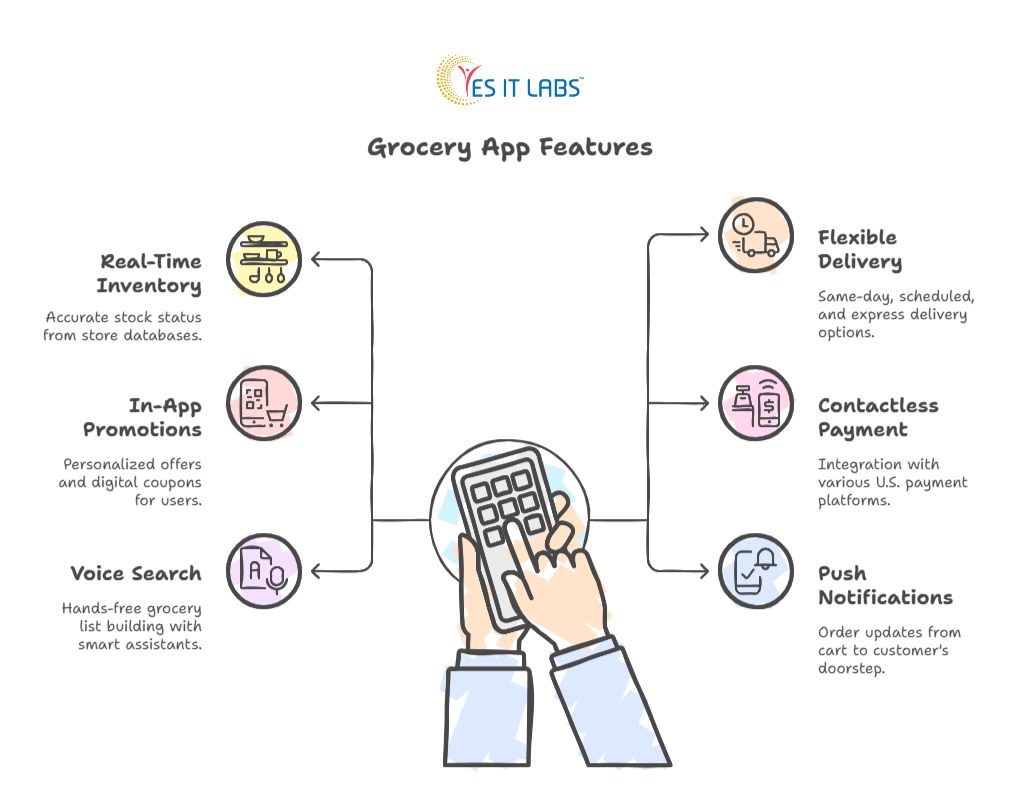In an age where speed, personalization, and convenience shape the American consumer experience, grocery delivery apps have become a cornerstone of digital retail. What began as a novelty in major urban areas has matured into a multibillion-dollar industry spanning the entire United States. From fresh produce and frozen meals to local farm goods and pantry staples, everything is now just a few taps away.
Behind this seamless shopping experience is a robust ecosystem of software innovation, real-time logistics, and smart personalization — all evolving through the power of grocery delivery app development. In this article, we’ll unpack the transformation of these platforms, the technologies driving them, and what it takes to thrive in the highly competitive U.S. market.
From Local Trials to National Demand
The grocery delivery app journey in the United States started with a few experimental launches in tech-forward cities like San Francisco and New York. Early apps were basic, offering online listings and simple checkout systems with fixed delivery schedules. Yet even in their limited forms, these platforms tapped into a growing demand: Americans wanted grocery convenience, especially as dual-income households, long work hours, and traffic congestion left little time for traditional shopping.
Fast forward to today, and grocery delivery has become a nationwide expectation. According to Statista, the U.S. online grocery market is expected to surpass $187 billion by 2024 — a massive leap from $95.8 billion in 2020. From Instacart and Amazon Fresh to regional players like Shipt and FreshDirect, the growth is undeniable.
Pandemic as a Digital Accelerator
COVID-19 dramatically altered consumer behavior across the U.S. as millions turned to contactless delivery for safety and convenience. What was once an occasional indulgence quickly became a daily habit. The pandemic forced even legacy grocery chains like Kroger, Walmart, and Safeway to fast-track their app development, revamp online operations, and scale delivery logistics.
Businesses sought out every available resource to meet this digital demand, and many partnered with a reliable android app development company in the USA. The focus was on rapid deployment, responsive UI, robust performance, and features like real-time inventory tracking, geofencing, and push notification systems to keep up with surging user expectations.
Key Features That Define U.S. Grocery Apps Today
To remain competitive in the U.S. market, grocery apps need more than just product listings. Today’s users expect speed, accuracy, and a seamless experience. Here are some must-have features for any modern American grocery delivery app:
- Real-Time Inventory Syncing: Connects directly with store databases to show accurate stock status.
- Flexible Delivery Windows: Offers same-day, scheduled, and express options.
- In-App Promotions: Personalized offers and digital coupons based on shopping history.
- Contactless Payment Options: Integration with Apple Pay, Google Pay, Venmo, and other U.S.-based payment platforms.
- Voice Search and Reordering: For hands-free grocery list building, integrated with smart assistants like Alexa and Siri.
- Push Notifications and Order Updates: Keeps customers informed from cart to doorstep.

Powering Speed with Logistics and AI
Grocery apps rely heavily on logistics networks and backend intelligence to operate efficiently across different U.S. regions. AI and machine learning tools now analyze customer patterns, predict restocks, suggest orders, and optimize delivery routes.
In urban cities like Chicago or Los Angeles, where traffic and density challenge last-mile delivery, apps use predictive analytics to deploy drivers more effectively. In suburban or rural areas, apps adjust delivery windows and work with local warehouses or micro-fulfillment centers to ensure smooth order processing.
Many brands also integrate location-based promotions, such as discounts on produce from local farms, tailored to ZIP code-specific campaigns.
Investing in Native iOS Applications
With nearly 57% of the U.S. smartphone market using iPhones, building dedicated iOS experiences is essential. While cross-platform development can work for MVPs, established grocery brands often invest in iOS application development service providers to ensure optimal performance for Apple users.
Native iOS apps offer faster load times, better responsiveness, and smoother integrations with Apple-exclusive features like Face ID, Haptic Touch, and Siri Shortcuts. In a country where premium user experience matters, especially among tech-savvy customers, cutting corners on app quality can cost market share.
Customer Retention Through Personalization
In the U.S., customer loyalty is fragile, and retention strategies must go beyond discounts. Grocery apps now employ:
- AI-Powered Recommendations – Suggesting recipes or reordering lists based on past behavior.
- Subscription Models – Walmart + and Amazon Fresh offer monthly subscriptions with benefits like free delivery or priority access to delivery slots.
- Dietary Filters – Options to shop gluten-free, vegan, organic, or allergen-free categories instantly.
- Loyalty Points and Referral Bonuses – Incentivizing regular use and word-of-mouth promotion.
All of this is managed through integrated CRMs and data dashboards, giving companies granular insight into what, when, and how Americans shop.
Hiring the Right Talent for Growth
As grocery apps become increasingly complex — blending UX design, AI features, inventory systems, and regional logistics — the demand for specialized development talent has surged. Many U.S. companies prefer to hire Android developer professionals with hands-on experience in eCommerce and logistics platforms.
These developers not only bring technical proficiency in languages like Kotlin and Java, but also understand U.S. consumer behavior, app compliance standards, and third-party integration protocols. Whether it’s building a new grocery app from scratch or upgrading an existing platform with new features, the right developer makes a measurable difference in go-to-market speed and product reliability.
Regulatory and Compliance Considerations in the U.S.
American grocery apps must comply with a range of legal and regulatory frameworks, including:
- PCI DSS Compliance: For secure handling of payment data.
- ADA Compliance: Ensuring accessibility for users with disabilities.
- CCPA (California Consumer Privacy Act): Governs data protection for California residents.
- FDA Integration: Required if apps sell supplements, baby food, or perishable goods requiring FDA approval.
Ignoring compliance can lead to lawsuits, penalties, and customer trust erosion, especially in regulation-heavy states like California, New York, and Illinois.
What’s Next: The Future of Grocery Delivery Apps in the U.S.
As digital adoption deepens and consumer expectations grow, the future of grocery delivery apps in America will hinge on:
● Hyper-Personalization
Expect more AI-led personalization, from dynamically adjusting delivery windows to offering smart shopping suggestions based on weather, holidays, or local trends.
● Drone and Autonomous Vehicle Deliveries
Pilots are already running in Texas and Florida. Once regulations relax, expect to see drones and sidewalk robots delivering groceries faster than ever before.
● Sustainable Delivery Practices
Apps will prioritize electric delivery fleets, carbon footprint tracking, and reusable packaging — reflecting the growing eco-conscious mindset of U.S. consumers.
● Voice-First Shopping
With 90 million Americans using smart speakers, voice-activated grocery ordering will likely become standard in most delivery apps.
Conclusion: Grocery Innovation at American Speed
In the United States, grocery delivery app development has evolved from simple convenience to essential infrastructure. As new players enter the market and established brands double down on digital strategy, one thing is clear — innovation must be continuous.
Whether you’re a supermarket chain, a startup entering the grocery tech space, or a logistics platform expanding your service offerings, success in this domain requires more than coding expertise. It demands an understanding of American consumer behavior, localized logistics, strong data privacy practices, and a commitment to seamless user experience.



